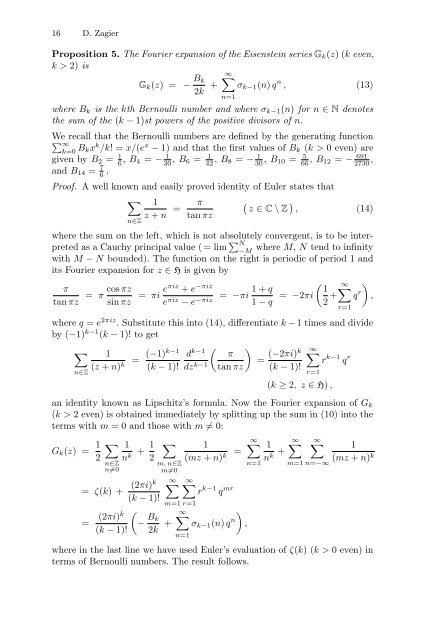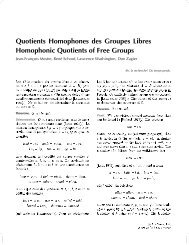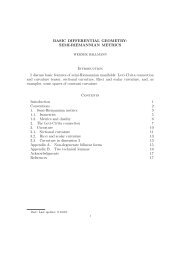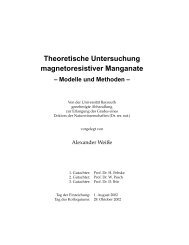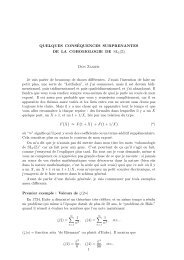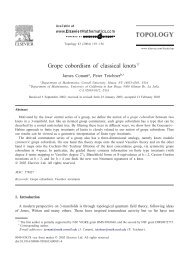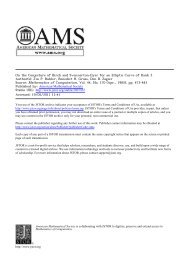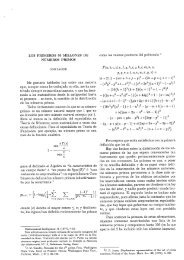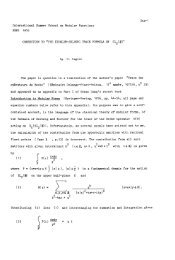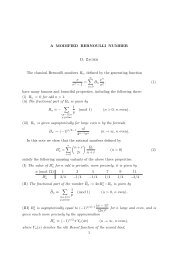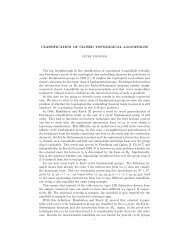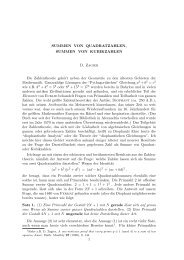Elliptic Modular Forms and Their Applications - Up To
Elliptic Modular Forms and Their Applications - Up To
Elliptic Modular Forms and Their Applications - Up To
Create successful ePaper yourself
Turn your PDF publications into a flip-book with our unique Google optimized e-Paper software.
16 D. ZagierProposition 5. The Fourier expansion of the Eisenstein series G k (z)(k even,k>2) isG k (z) = − B ∞ k2k + ∑σ k−1 (n) q n , (13)n=1where B k is the kth Bernoulli number <strong>and</strong> where σ k−1 (n) for n ∈ N denotesthe sum of the (k − 1)st powers of the positive divisors of n.We∑recall that the Bernoulli numbers are defined by the generating function∞k=0 B kx k /k! =x/(e x − 1) <strong>and</strong> that the first values of B k (k>0 even) aregiven by B 2 = 1 6 , B 4 = − 1 30 , B 6 = 142 , B 8 = − 1 30 , B 10 = 5 66 , B 12 = − 6912730 ,<strong>and</strong> B 14 = 7 6 .Proof. A well known <strong>and</strong> easily proved identity of Euler states that∑n∈Z1z + n =πtan πz(z ∈ C \ Z), (14)where the sum on the left, which is not absolutely convergent, is to be interpretedas a Cauchy principal value ( = lim ∑ N−Mwhere M, N tend to infinitywith M − N bounded). The function on the right is periodic of period 1 <strong>and</strong>its Fourier expansion for z ∈ H is given byπtan πz= πcos πzsin πz= πi eπiz + e −πiz 1+qe πiz = −πi− e−πiz 1 − q = −2πi ( 12 + ∞ ∑r=1q r ),where q = e 2πiz . Substitute this into (14), differentiate k − 1 times <strong>and</strong> divideby (−1) k−1 (k − 1)! to get∑ 1(z + n) k = (−1)k−1 d k−1 ( ) π∞∑(k − 1)! dz k−1 = (−2πi)k r k−1 q rtan πz (k − 1)!n∈Zr=1(k ≥ 2, z∈ H) ,an identity known as Lipschitz’s formula. Now the Fourier expansion of G k(k >2 even) is obtained immediately by splitting up the sum in (10) into theterms with m =0<strong>and</strong> those with m ≠0:G k (z) = 1 2∑n∈Zn≠01n k + 1 2= ζ(k) + (2πi)k(k − 1)!= (2πi)k(k − 1)!∑m, n∈Zm≠0(− B k2k +∞∑m=1 r=1∑∞1∞(mz + n) k = ∑n=1∞∑r k−1 q mrσ k−1 (n) q n ),n=11∞n k + ∑∞∑m=1 n=−∞1(mz + n) kwhere in the last line we have used Euler’s evaluation of ζ(k) (k >0 even) interms of Bernoulli numbers. The result follows.


